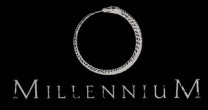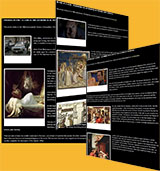The Marburg Virus and Prions
The Marburg Virus and Prions, courtesy of Wikipedia, the free encyclopaedia
The Marburg virus is the causative agent of Marburg haemorrhagic fever. Both the disease and virus are related to Ebola and originate in the same part of Africa (Uganda and Eastern Congo). The zoonosis is of unknown origin, but some scientists believe it may be hosted by bats.
The disease is spread through bodily fluids, including blood, excrement, saliva, and vomit. There is no cure or vaccine for this deadly and infectious virus. Victims suffer a high fever, diarrhoea, vomiting, and severe bleeding from bodily orifices and usually die within a week. Fatality rates range from 25 to 100%.
In the spring of 2005, the virus attracted widespread press attention for an outbreak in Angola. Beginning in October 2004 and continuing into 2005, the outbreak was the world‘ worst epidemic of any kind of haemorrhagic fever.
The Marburg virus
The viral structure is typical of filoviruses, with long threadlike particles which have a consistent diameter but vary greatly in length from an average of 800 nanometers up to 14,000 nm, with peak infectious activity at about 790 nm. Virions (viral particles) contain seven known structural proteins. While nearly identical to Ebola virus in structure, Marburg virus is antigenically distinct from Ebola virus - in other words, it triggers different antibodies in infected organisms. It was the first filovirus to be identified. Briefly described in the book written by Richard Preston entitled The Hot Zone.
Infection details
Because many of the signs and symptoms of Marburg haemorrhagic fever are similar to those of other infectious diseases, such as malaria or typhoid, diagnosis of the disease can be difficult, especially if only a single case is involved.
The disease is characterised by the sudden onset of fever, headache, and muscle pain after an incubation period of 3-9 days. Within a week, a maculopapular rash develops, followed by vomiting, chest and abdominal pain, and diarrhoea. The symptoms soon increase in severity leading to jaundice, delirium, organ failure, and extensive hemorrhage. Patients generally die from hypovolemic shock as fluid leaks out of the blood vessels, causing blood pressure to drop. Depending upon health care and hospitalization support, the disease can have very high fatality rates, with estimates ranging from 25% up to 100%. If a patient survives, recovery from the disease is prolonged and can be marked by inflammation or infection of various organs, including: orchitis (testicles), hepatitis (liver), transverse myelitis (spinal cord), uveitis (eyes), or parotitis (salivary glands).
According to a report in The New York Times, the virus moves very quickly. "On Day 3 of the infection, fewer than 200 viruses are in a drop of blood. By Day 8, there are five million."
Treatment and prevention
As with other hemorrhagic fever viruses, the treatment options for Marburg are limited. Hypotension and shock may require early administration of vasopressors and haemodynamic monitoring with attention to fluid and electrolyte balance, circulatory volume, and blood pressure. Viral hemorrhagic fever (VHF) patients tend to respond poorly to fluid infusions and rapidly develop pulmonary edema. This is especially true of patients infected with Hantaan and Seoul viruses.
Caregivers require barrier infection control measures including double gloves, impermeable gowns, face shields, eye protection, leg and shoe coverings.
A few research groups are working on drugs and vaccines to fight the virus. In 1998, a group at the United States Army Medical Research Institute of Infectious Diseases published the first peer reviewed article detailing the development of the first experimental Marburg virus vaccine demonstrated to completely protect animals from lethal Marburg virus infection. Following, in 2002, Genphar, a company doing research for the United States Army‘ biodefense program, announced that an experimental vaccine protected animals from a high dose of Marburg virus. The tests were conducted by the United States Army Medical Research Institute of Infectious Diseases (USAMRIID). According to the company, all animals in the control group died within days whereas all animals that received the regular dosage of the vaccine were fully protected. The company has moved on to non-human primate trials. Late in 2003, the US government awarded the company a contract worth $8.4 million for what was described as "a multivalent Ebola, Marburg filovirus vaccine program".
In June 2005 scientists at Canada‘ National Microbiology Laboratory announced that they had also developed vaccines for both Marburg and Ebola that showed significant promise in primate testing. Studies on mice also suggested that the vaccine might be an effective treatment for the disease if it is administered shortly after a patient is infected. To make the vaccines the scientists fused a surface protein from the viruses they hope to protect against onto an animal virus - vesicular stomatitis - which is thought to be of no threat to humans. In the rhesus macaque monkey model of the disease, the vaccine is effective even when given after infection with the virus.
Prions
A prion - short for proteinaceous infectious particle that lacks nucleic acid (by analogy to virion) - is a type of infectious agent made only of protein. Prions are believed to infect and propagate by refolding abnormally into a structure which is able to convert normal molecules of the protein into the abnormally structured form. However, the term in itself does not preclude other mechanisms of transmission.
Prions are generally quite resistant to denaturation by protease, heat, radiation, and formalin treatments, although potency or infectivity can be reduced. Ozone sterilization is currently being studied as a potential method for prion deactivation.
Although genetic research may shed light on prions, and there is a genetic component to many prion diseases, prion diseases are not exclusively genetic diseases and are grouped as transmissible spongiform encephalopathies. Diseases as varied as fatal familial insomnia and kuru (translated as "to tremble with fear") are believed to be associated with prions. Other prion diseases include scrapie (a disease of sheep), chronic wasting disease, (in deer and elk), variant Creutzfeldt-Jakob disease (vCJD), and bovine spongiform encephalopathy (BSE or mad cow disease), all caused by similar proteins in different species. It should be noted that the same gene is responsible for spongiform encephalopathies which are not known to be transmissible, as well as some non-neurological diseases. Some require a mutation for transmission to occur, and there are respective mutations which can prevent transmission for most of the TSEs. Whether or not the prion gene has a non-disease function is an area of considerable active research.
All of these diseases affect the structure of the brain or other neural tissue, and all are untreatable and fatal. However, a vaccine has been developed in mice that may provide insight into providing a vaccine in humans to resist prion infections.
Proteins showing prion behaviour are also found in some fungi. Some fungal prions may not be associated with any disease; it is unknown whether these prions represent an evolutionary advantage for their hosts. All known prions are believed to infect and propagate by formation of an amyloid fold, in which the protein polymerizes into a fibre with a core consisting of tightly packed beta sheets. Other mechanisms may exist in yet undiscovered infectious protein particles.
You can read much more about Marburg Virus and Prions at Wikipedia, the free encyclopedia.






